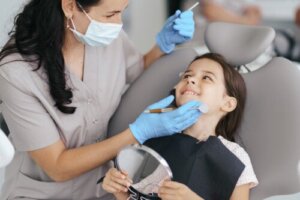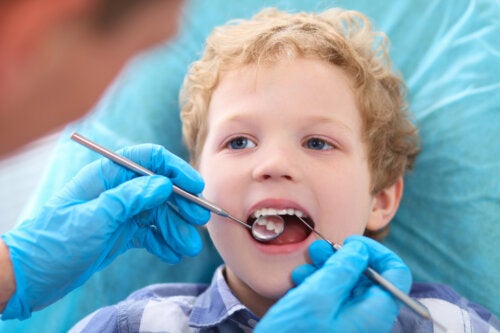Is It Possible to Treat Children's Cavities Without Anesthesia?


Written and verified by the dentist Vanesa Evangelina Buffa
Many parents wonder if it’s possible to treat their children’s cavities without anesthesia. Fear of needles and anxiety about dental procedures unsettles children of all ages.
Fear of dental procedures shouldn’t stop your little one from getting the care they need. If your child has a cavity lesion in their teeth, it’s essential to have it treated in a timely manner. This will prevent the condition from progressing and causing further discomfort.
Nowadays, it’s possible to implement techniques capable of treating cavities in children without the need for anesthesia. But these procedures aren’t applicable in all cases. In this article, we’ll tell you about the different therapeutic options and when they’re performed.

Treating cavities in children
Dental cavities are the most common chronic oral disease worldwide. According to data from the World Health Organization, in 2017, more than 530 million children around the world had this disease in their baby teeth.
If cavities in children aren’t treated, tooth destruction progresses. This affects the daily lives of young children and can lead to health complications. Pain, abscesses, stained and broken teeth, bite problems, and conditions in the permanent teeth while they’re forming are the consequences of untreated cavities.
In general, cavity treatment consists of cleaning the affected areas of the tooth and filling the cavities with special materials. But in pediatric dentistry, due to the special needs of children, there are many alternatives to solve this oral problem. Some of them without the noise of the drill or the pricks of anesthesia.
To choose the most appropriate treatment for each child, a pediatric dentist considers several factors:
- The child’s age and ability to cooperate during treatment
- Whether the lesion is on a primary or permanent tooth
- In the case of temporary teeth, how much time the tooth has left to erupt and change
- The size and depth of the lesion
- If there’s involvement of the pulp and other nearby structures
With all this information, the dentist chooses the treatment alternative that best suits the reality of their little patient. Some methods, as we’ll tell you, can be performed without anesthesia. In other cases, it’s necessary to desensitize a portion of the mouth in order to be able to perform dental procedures without the child feeling pain. Let’s take a closer look at the different options.
Treating children’s cavities without anesthesia
There are non-invasive techniques that allow cavity lesions to be reversed or controlled without the need to use a turbine or apply a local anesthetic. In general, these procedures are used to treat lesions that are just beginning or to stop carious processes that don’t involve the dental pulp, especially in baby teeth. These are the most commonly used options in children.
Remineralization of incipient cavities
According to a bibliographic review published in the Revista Cubana de Estomatología, remineralization consists of the incorporation of minerals into a demineralized dental area for its repair. This process is useful for reversing cavities that have just begun.
When cavities begin, they affect only the dental enamel. It looks like a white, opaque stain without cavitation. With the application of some special products, it’s possible for this area of the tooth to recover the lost minerals and for the disease to be reversed.
To perform this treatment, remineralizing solutions or gels based on calcium, phosphates, or fluoride are used. In some cases, laser therapy is also applied. This procedure can be performed on both primary and permanent teeth. It’s a non-invasive alternative, painless, easy to apply, and very comfortable for children.
Cariostatics
Cariostatics are agents that inhibit the progression of caries, reduce sensitivity, and remineralize damaged dentin. Silver diamine fluoride (SDF) is one of the most commonly used in pediatric dentistry. This liquid is easy to apply, but it causes darkening of the teeth. For this reason, it’s mainly used on baby teeth.
It’s applied on tooth elements with cavities in order to harden the damaged tissues and prevent the proliferation of new bacteria. An article in the International Journal of Interdisciplinary Dentistry suggests that FDP can stop cavitated dentin lesions.
Cariostatic agents can be applied as soon as cavities are detected. The procedure consists of “painting” the damaged tooth surface with a small brush. Sometimes several applications are necessary.
This treatment is painless, non-invasive, quick, and easy to perform. When the carious process is stopped, the pediatric dentist should perform regular check-ups or complement the treatment with other additional therapies.
Atraumatic restorative treatments (ART)
The atraumatic restorative method is a procedure that consists of removing cavities with the use of manual instruments and without applying anesthesia. The damaged tissues are removed with small “spoons” and then the tooth is filled with fluoride-releasing glass ionomers.
This technique preserves healthy dental tissue and restores the tooth with esthetic materials that are easy to place in children. According to a study published at the European University, it’s a simple, preventive, and curative option indicated for treating cavities in young, fearful children and patients with disabilities, and when the use of rotary instruments isn’t possible.
Microabrasion
Dental microabrasion is another non-invasive option for treating incipient cavities without the use of anesthesia. This procedure involves the removal of damaged enamel through a jet of microparticles mixed with air and water at high pressure.
With this procedure, it’s possible to preserve most of the healthy tooth structure. The remaining tissue is filled with composites, achieving very esthetic results.

Chemical-mechanical systems
This technique is widely used by some pediatric dentists. It consists of placing special gels inside the carious lesions to eliminate the damaged tissue without causing any pain. Therefore, the use of anesthesia isn’t necessary.
Once the substance has acted, it’s removed with a spoon. Then, the tooth cavity is filled with a conventional filling material.
A study by the University of Tacna suggests that the use of these gels has a higher degree of acceptability with respect to techniques that use conventional rotary instruments. However, it requires more working time.
The Hall technique
The Hall technique is a useful alternative for treating cavities in children without using anesthesia. It consists of sealing the lesion by cementing preformed metal crowns without abrading the tooth with rotary instruments.
The purpose of this procedure is to prevent the progression of the disease by isolating the lesion from the oral environment. By changing the internal conditions of the cavities, the bacteria that cause it cease to obtain the substrates they need to proliferate, and the destructive process is stopped. It’s indicated in baby molars that don’t have compromised pulp.
When is it necessary to use anesthesia to treat cavities in children?
Although there are procedures to treat cavities in children that don’t require the use of anesthesia, some cases do require its use. Although it’s necessary to prick children’s mouths, using this substance allows more complex treatments to be performed without your little one feeling pain or discomfort.
These are some situations in which the children’s dentist may suggest the use of anesthesia to treat cavities in children and avoid pain and fear during the process:
- Fillings: These are performed when the cavity lesions are deeper but haven’t affected the dental nerve. The damaged area is cleaned with rotary instruments and then the cavity is filled with a filling.
- Pulp treatments: When cavities involve the dental pulp, which is the innermost soft tissue of the teeth, pulp treatments are performed. Depending on the case, the professional removes part or all of the pulp tissue and seals the spaces it occupied with special materials.
- Tooth extraction: Although the preservation of teeth is the main objective of dentists, there are cases of irreversible cavities that require tooth extraction.
The last word will always be the pediatric dentist’s
The application of local anesthesia and sedation techniques in children allows some cavity treatments to be performed without pain, discomfort, or anxiety. Especially when less invasive methods aren’t possible. These are safe methods that pediatric dentists know how to perform and use to ensure a pleasant experience for their patients.
The professional’s goal is to always provide the safest and most painless treatment. In many cases, cavities can be treated without using anesthesia, especially in baby teeth or when the lesions have just begun. However, if the disease has advanced or the case warrants it, procedures with anesthesia will be necessary to ensure the comfort and well-being of the child.
Many parents wonder if it’s possible to treat their children’s cavities without anesthesia. Fear of needles and anxiety about dental procedures unsettles children of all ages.
Fear of dental procedures shouldn’t stop your little one from getting the care they need. If your child has a cavity lesion in their teeth, it’s essential to have it treated in a timely manner. This will prevent the condition from progressing and causing further discomfort.
Nowadays, it’s possible to implement techniques capable of treating cavities in children without the need for anesthesia. But these procedures aren’t applicable in all cases. In this article, we’ll tell you about the different therapeutic options and when they’re performed.

Treating cavities in children
Dental cavities are the most common chronic oral disease worldwide. According to data from the World Health Organization, in 2017, more than 530 million children around the world had this disease in their baby teeth.
If cavities in children aren’t treated, tooth destruction progresses. This affects the daily lives of young children and can lead to health complications. Pain, abscesses, stained and broken teeth, bite problems, and conditions in the permanent teeth while they’re forming are the consequences of untreated cavities.
In general, cavity treatment consists of cleaning the affected areas of the tooth and filling the cavities with special materials. But in pediatric dentistry, due to the special needs of children, there are many alternatives to solve this oral problem. Some of them without the noise of the drill or the pricks of anesthesia.
To choose the most appropriate treatment for each child, a pediatric dentist considers several factors:
- The child’s age and ability to cooperate during treatment
- Whether the lesion is on a primary or permanent tooth
- In the case of temporary teeth, how much time the tooth has left to erupt and change
- The size and depth of the lesion
- If there’s involvement of the pulp and other nearby structures
With all this information, the dentist chooses the treatment alternative that best suits the reality of their little patient. Some methods, as we’ll tell you, can be performed without anesthesia. In other cases, it’s necessary to desensitize a portion of the mouth in order to be able to perform dental procedures without the child feeling pain. Let’s take a closer look at the different options.
Treating children’s cavities without anesthesia
There are non-invasive techniques that allow cavity lesions to be reversed or controlled without the need to use a turbine or apply a local anesthetic. In general, these procedures are used to treat lesions that are just beginning or to stop carious processes that don’t involve the dental pulp, especially in baby teeth. These are the most commonly used options in children.
Remineralization of incipient cavities
According to a bibliographic review published in the Revista Cubana de Estomatología, remineralization consists of the incorporation of minerals into a demineralized dental area for its repair. This process is useful for reversing cavities that have just begun.
When cavities begin, they affect only the dental enamel. It looks like a white, opaque stain without cavitation. With the application of some special products, it’s possible for this area of the tooth to recover the lost minerals and for the disease to be reversed.
To perform this treatment, remineralizing solutions or gels based on calcium, phosphates, or fluoride are used. In some cases, laser therapy is also applied. This procedure can be performed on both primary and permanent teeth. It’s a non-invasive alternative, painless, easy to apply, and very comfortable for children.
Cariostatics
Cariostatics are agents that inhibit the progression of caries, reduce sensitivity, and remineralize damaged dentin. Silver diamine fluoride (SDF) is one of the most commonly used in pediatric dentistry. This liquid is easy to apply, but it causes darkening of the teeth. For this reason, it’s mainly used on baby teeth.
It’s applied on tooth elements with cavities in order to harden the damaged tissues and prevent the proliferation of new bacteria. An article in the International Journal of Interdisciplinary Dentistry suggests that FDP can stop cavitated dentin lesions.
Cariostatic agents can be applied as soon as cavities are detected. The procedure consists of “painting” the damaged tooth surface with a small brush. Sometimes several applications are necessary.
This treatment is painless, non-invasive, quick, and easy to perform. When the carious process is stopped, the pediatric dentist should perform regular check-ups or complement the treatment with other additional therapies.
Atraumatic restorative treatments (ART)
The atraumatic restorative method is a procedure that consists of removing cavities with the use of manual instruments and without applying anesthesia. The damaged tissues are removed with small “spoons” and then the tooth is filled with fluoride-releasing glass ionomers.
This technique preserves healthy dental tissue and restores the tooth with esthetic materials that are easy to place in children. According to a study published at the European University, it’s a simple, preventive, and curative option indicated for treating cavities in young, fearful children and patients with disabilities, and when the use of rotary instruments isn’t possible.
Microabrasion
Dental microabrasion is another non-invasive option for treating incipient cavities without the use of anesthesia. This procedure involves the removal of damaged enamel through a jet of microparticles mixed with air and water at high pressure.
With this procedure, it’s possible to preserve most of the healthy tooth structure. The remaining tissue is filled with composites, achieving very esthetic results.

Chemical-mechanical systems
This technique is widely used by some pediatric dentists. It consists of placing special gels inside the carious lesions to eliminate the damaged tissue without causing any pain. Therefore, the use of anesthesia isn’t necessary.
Once the substance has acted, it’s removed with a spoon. Then, the tooth cavity is filled with a conventional filling material.
A study by the University of Tacna suggests that the use of these gels has a higher degree of acceptability with respect to techniques that use conventional rotary instruments. However, it requires more working time.
The Hall technique
The Hall technique is a useful alternative for treating cavities in children without using anesthesia. It consists of sealing the lesion by cementing preformed metal crowns without abrading the tooth with rotary instruments.
The purpose of this procedure is to prevent the progression of the disease by isolating the lesion from the oral environment. By changing the internal conditions of the cavities, the bacteria that cause it cease to obtain the substrates they need to proliferate, and the destructive process is stopped. It’s indicated in baby molars that don’t have compromised pulp.
When is it necessary to use anesthesia to treat cavities in children?
Although there are procedures to treat cavities in children that don’t require the use of anesthesia, some cases do require its use. Although it’s necessary to prick children’s mouths, using this substance allows more complex treatments to be performed without your little one feeling pain or discomfort.
These are some situations in which the children’s dentist may suggest the use of anesthesia to treat cavities in children and avoid pain and fear during the process:
- Fillings: These are performed when the cavity lesions are deeper but haven’t affected the dental nerve. The damaged area is cleaned with rotary instruments and then the cavity is filled with a filling.
- Pulp treatments: When cavities involve the dental pulp, which is the innermost soft tissue of the teeth, pulp treatments are performed. Depending on the case, the professional removes part or all of the pulp tissue and seals the spaces it occupied with special materials.
- Tooth extraction: Although the preservation of teeth is the main objective of dentists, there are cases of irreversible cavities that require tooth extraction.
The last word will always be the pediatric dentist’s
The application of local anesthesia and sedation techniques in children allows some cavity treatments to be performed without pain, discomfort, or anxiety. Especially when less invasive methods aren’t possible. These are safe methods that pediatric dentists know how to perform and use to ensure a pleasant experience for their patients.
The professional’s goal is to always provide the safest and most painless treatment. In many cases, cavities can be treated without using anesthesia, especially in baby teeth or when the lesions have just begun. However, if the disease has advanced or the case warrants it, procedures with anesthesia will be necessary to ensure the comfort and well-being of the child.
All cited sources were thoroughly reviewed by our team to ensure their quality, reliability, currency, and validity. The bibliography of this article was considered reliable and of academic or scientific accuracy.
- Arenas Tapia, A. A. (2019). Eficacia de la papaína en la remoción química-mecánica de la caries. https://repositorio.upt.edu.pe/handle/20.500.12969/2240
- Duque de Estrada Riverón, J., Hidalgo-Gato Fuentes, I., & Pérez Quiñónez, J. A. (2006). Técnicas actuales utilizadas en el tratamiento de la caries dental. Revista cubana de Estomatología, 43(2), 0-0. http://scielo.sld.cu/scielo.php?pid=S0034-75072006000200009&script=sci_arttext&tlng=en
- Muñoz-Sandoval, C., Gambetta-Tessini, K., Santamaría, R. M., Splieth, C., Paris, S., Schwendicke, F., & Giacaman, R. A. (2022). ¿ Cómo Intervenir el Proceso de Caries en Niños? Adaptación del Consenso de ORCA/EFCD/DGZ. International journal of interdisciplinary dentistry, 15(1), 48-53. https://www.scielo.cl/scielo.php?pid=S2452-55882022000100048&script=sci_arttext
- Oliva Delgado, C. R. (2021). Tratamiento restaurador atraumático en odontopediatría. https://titula.universidadeuropea.com/handle/20.500.12880/652
- Organización Mundial de la Salud. (2021). Poner fin a la caries dental en la infancia: manual de aplicación de la OMS. Organización Mundial de la Salud. Licencia: CC BY-NC-SA 3.0 IGO. https://apps.who.int/iris/handle/10665/340445.
- Wakhloo, T., Reddy, S. G., Sharma, S. K., Chug, A., Dixit, A., & Thakur, K. (2021). Silver diamine fluoride versus atraumatic restorative treatment in pediatric dental caries management: A systematic review and meta-analysis. Journal of International Society of Preventive & Community Dentistry, 11(4), 367. https://www.ncbi.nlm.nih.gov/pmc/articles/PMC8352060/
This text is provided for informational purposes only and does not replace consultation with a professional. If in doubt, consult your specialist.








